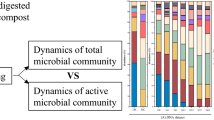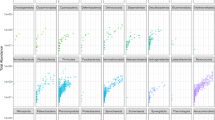Abstract
Bacterial diversity during in-vessel (rotary drum) composting of agricultural waste was characterized using NGS-based 16S rRNA sequencing for microbial identification. The activity of the bacteria was observed to vary with the composting materials and degradation pattern. Taxonomic hits distribution at domain level revealed that 89.5% sequences belonged to bacteria, 9% to eukaryota followed by 1.4% archaea during drum composting. The lowest common ancestor (LCA) classification plot showed the high abundance of the phylum proteobacteria followed by actinobacteria in compost sample. Taxonomic hit distribution at family level showed that compost sample was enriched with Thermomonosporaceae. Thermomonospora curvata is an aerobic, cellulolytic, thermophilic Gram-positive bacterium which produces a number of industrially important compounds, i.e., cellulase, alpha-amylase, and polygalacturonate lyase. Thermomonospora family of bacteria play a major role in organic matter degradation during composting. Hence, in the present study species such as Actinomadura vinacea, Thermomonospora curvata, Actinoallomurus spadix, Actinomadura rubrobrunea. T. curvata were identified from the compost mixture, which can utilize many organic compounds such as cellulose starch, xylose or pectin. The other biggest group in compost sample was Actinobacteria with Thermoleophilum album as the most abundant species followed by Collinsella aerofaciens. The compost was stabilized with higher volatile solids reduction, lower OUR (4.49 mg/g VS/day) and CO2 (2.28 mg/g VS/day) values at the end of 20 days. The final compost was observed with 2.31% of TKN and 4.3% of phosphorus. Finally the results indicate that degradation of agricultural waste using drum composter was dominated by Bacilli, γ, β-proteobacteria, and actinobacteria.





Similar content being viewed by others
References
Amann RI, Ludwig W, Schleifer KH (1995) Phylogenetic identification and in situ detection of individual microbial cells without cultivation. Microbiol Rev 59(1):143–169
APHA (2005) Standard methods for the examination of water and wastewater, 19th edn. American Public Health Association, Washington, DC
Aranda TRobledo-Mahon,E, Pesciaroli C, Rodríguez-Calvo A, Silva-Castro GA, Gonzalez-Lopez J, Calvo C (2018) Effect of semi-permeable cover system on the bacterial diversity during sewage sludge composting. J Environ Manag 215:57–67
Bhatia A, Ali M, Sahoo J, Madan S, Pathania R, Ahmed N, Kazmi AA (2012) Microbial diversity during rotary drum and Windrow Pile composting. J Basic Microb 52(1):5–15
Bhatia A, Madan S, Sahoo J, Ali M, Pathania R, Kazmi AA (2013) Diversity of bacterial isolates during full scale rotary drum composting. Waste Manag 33(7):1595–1601
Chandna P, Nain L, Singh S, Kuhad RC (2013) Assessment of bacterial diversity during composting of agricultural byproducts. BMC Microbiol 13:99. https://doi.org/10.1186/1471-2180-13-99
Danon M, Franke-Whittle IH, Insam H, Chen Y, Hadar Y (2008) Molecular analysis of bacterial community succession during prolonged compost curing. FEMS Microbiol Ecol 65:133–144
de Gannes VD, Eudoxie G, Hickey WJ (2013) Prokaryotic successions and diversity in composts as revealed by 454-pyrosequencing. Bioresour Technol 133:573–580
Egert M, Marhan S, Wagner B, Scheu S, Friedrich MW (2004) Molecular profiling of 16S rRNA genes reveals diet-related differences of microbial communities in soil, gut, and casts of Lumbricus terrestris L. (Oligochaeta: Lumbricidae). FEMS Microbiol Ecol 48:187–197
Epstein E (1997) The science of composting. Technomic Publishing Company Inc, Basel
Farris MH, Olson JB (2007) Detection of Actinobacteria cultivated from environmental samples reveals bias in universal primers. Lett Appl Microbiol 45(4):376–381
Franke-Whittle IH, Confalonieri A, Insam H, Schlegelmilch M, Körner I (2014) Changes in the microbial communities during co-composting of digestates. Waste Manag 34:632–641
Golueke CG (1992) Bacteriology of composting. Biocycle 33(1):55–57
Hadar Y, Papadopoulou KK (2012) Suppressive composts: microbial ecology links between abiotic environments and healthy plants. Ann Rev Phytopathol 50:133–153
Hargerty DJ, Pavoni JL, Heer JE (1999) Solid waste management. Van Nostrand Reinhold, New York, pp 12–13
Kalamdhad AS, Pasha M, Kazmi AA (2008) Stability evaluation of compost by respiration techniques in a rotary drum composter. Resour Conserv Recycl 52(5):829–834
Kalamdhad AS, Singh YK, Ali M, Khwairakpam M, Kazmi AA (2009) Rotary drum composting of vegetable waste and tree leaves. Bioresour Technol 100(24):6442–6450
Liu J, Li W, Xu XH, Li HT (2011) Effect of cellulose-decomposing strain on microbial community of cow manure compost. Ann Microbiol 32(10):3073–3081
Mahon TR, Aranda E, Pesciaroli C, Calvo AR, Castro GAS, Lopez JG, Calvo C (2018) Effect of semi-permeable cover system on the bacterial diversity during sewage sludge composting. J Environ Manag 215:57–67
Meng X, Liu B, Xi C, Luo X, Yuan X, Wang X, Zhu W, Wang H, Cui Z (2018) Effect of pig manure on the chemical composition and microbial diversity during co-composting with spent mushroom substrate and rice husks. Bioresour Technol 251:22–30
Neher DA, Weicht TR, Bates ST, Leff JW, Fierer N (2013) Changes in bacterial and fungal communities across compost recipes, preparation methods, and composting times. PLoS ONE 8(11):e79512
Ryckeboer J, Mergaert J, Coosemans J, Deprins K, Swings J (2003) Microbiological aspects of biowaste during composting in monitored compost bin. J Appl Microbiol 94(1):127–137
Steger K, Sjogren AM, Jarvis A, Jansson JK, Sundh I (2007) Development of compost maturity and Actinobacteria populations during full-scale composting of organic household waste. J Appl Microbiol 103:487–498
Tiquia SM, Tam NYM (2000) Fate of nitrogen during composting of chicken litter. Environ Pollut 110(3):535–541
Trautmann N, Olynciw E (2012) http://compost.css.cornell.edu/microorg.html. Accessed 20 Sep 2012
Varma VS, Kalamdhad AS (2014a) Evolution of chemical and biological characterization during thermophilic composting of vegetable waste using rotary drum composter. Int J Environ Sci Technol 12(6):2015–2024
Varma VS, Kalamdhad AS (2014b) Stability and microbial community analysis during rotary drum composting of vegetable waste. Int J Recycl Org Waste Agric 3:52. https://doi.org/10.1007/s40093-014-0052-4
Villar I, Alves D, Garrido J, Mato S (2016) Evolution of microbial dynamics during the maturation phase of the composting of different types of waste. Waste Manag 54:83–92
Wang X, Cui H, Shi J, Zhao X, Zhao Y, Wei Z (2015) Relationship between bacterial diversity and environmental parameters during composting of different raw materials. Bioresour Technol 198:395–402
Yamane T (2013) Denitrifying bacterial community in manure compost pellets applied to an Andosol upland field. Soil Sci Plant Nutr 59(4):572–579. https://doi.org/10.1080/00380768.2013.813832
Zucconi F, de Bertoldi Ferranti MP, Hermite PL (1987) Compost specifications for the production and characterization of compost from municipal solid waste. Compost: production quality and use. Elsevier, Barking, pp 30–50
Acknowledgements
The authors gratefully acknowledge the financial support of the Ministry of Drinking Water and Sanitation, Government of India (Grant no. W. 11035/07/2011-CRSP (R&D) 12/12/2011).
Author information
Authors and Affiliations
Corresponding author
Ethics declarations
Conflict of interest
The authors declare that there is no conflict of interests regarding the publication of this paper.
Rights and permissions
About this article
Cite this article
Varma, V.S., Dhamodharan, K. & Kalamdhad, A.S. Characterization of bacterial community structure during in-vessel composting of agricultural waste by 16S rRNA sequencing. 3 Biotech 8, 301 (2018). https://doi.org/10.1007/s13205-018-1319-7
Received:
Accepted:
Published:
DOI: https://doi.org/10.1007/s13205-018-1319-7




